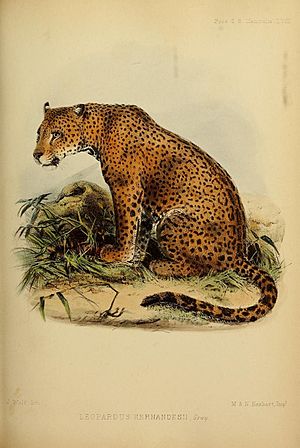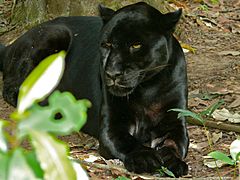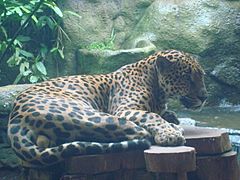North American jaguar facts for kids
Quick facts for kids North American jaguar |
|
|---|---|
 |
|
| El Jefe in Arizona | |
 |
|
| A jaguar in Belize | |
| Conservation status | |
| Scientific classification | |
| Kingdom: | Animalia |
| Phylum: | Chordata |
| Class: | Mammalia |
| Order: | Carnivora |
| Suborder: | Feliformia |
| Family: | Felidae |
| Subfamily: | Pantherinae |
| Genus: | Panthera |
| Species: | P. onca |
The North American jaguar is a type of jaguar (Panthera onca) that lives in North America. You can find them from the Southwestern United States all the way down to Central America. While jaguars are often linked to South America, this group has faced a big decline. By the 1960s, they had almost disappeared from the United States.
Scientists have studied their bodies and DNA and found that all jaguars are very similar. This means there aren't different subspecies (or types) of jaguars.
This group of jaguars is sometimes called the "American jaguar" or "Central American jaguar."
Contents
Jaguar History and Types
In the past, scientists thought there were many different types of jaguars, called subspecies. They gave them names like Panthera onca goldmani for jaguars in Mexico and Central America, and Panthera onca hernandesii for those in Mexico and the United States.
However, in 1939, a scientist named Reginald Innes Pocock looked closely at jaguars and couldn't find enough differences to call them separate subspecies. More recent tests using DNA have also shown that jaguars are all part of one big species.
How Jaguars Evolved
Scientists believe that modern jaguars came from an ancient cat ancestor in Asia. These ancestors crossed a land bridge called Beringia into North America a very long time ago, during the Early Pleistocene ice age. From North America, they then spread into Central and South America.
The ancient jaguars in North America were known as Panthera onca augusta. During the Pleistocene epoch, jaguars lived in many more places across North America. Their range reached as far as Nebraska, Washington, and Maryland. Many jaguar fossils have been found, especially in Florida and eastern Tennessee. Jaguars were much more common in Florida than other big cats.
What North American Jaguars Look Like
While male jaguars in South America can weigh up to about 120 kilograms (265 pounds), jaguars in Central or North America are usually smaller. For example, jaguars living in a reserve on Mexico's Pacific coast weigh around 50 kilograms (110 pounds). This is similar to the weight of female cougars. The average weight for six male jaguars in Belize was about 57 kilograms (126 pounds), which is similar to female jaguars in South America.
Jaguar Life and Habits
In northeastern Mexico, jaguars live in the same areas as cougars. Both cats are mostly active at night. They hunt animals like white-tailed deer, collared peccary (a pig-like animal), and young cattle.
Other predators that live in the same area include the American black bear. In the past, the Mexican grizzly bear and Mexican wolf also lived there. There's even evidence that a jaguar nicknamed El Jefe, who lived in the southwestern United States, hunted a young American black bear.
In 2018, a jaguar named Valerio escaped from its enclosure at the Audubon Zoo in New Orleans, Louisiana. It killed some other animals in the zoo before being safely captured. This behavior, though scary, was seen as normal for a jaguar defending its territory.
Where Jaguars Live
In North America, jaguars currently live from the southern part of the United States down to the southern part of Central America. As recently as 2016, jaguars from Mexico have been seen in Arizona.
Historically, jaguars lived in a much wider area. Records show they reached as far north as Colorado and California. There are also less certain records suggesting they might have lived in the Pacific Northwest, Pennsylvania, Ohio, and Florida. These older records might be linked to the larger ancient jaguars from the Pleistocene era.
Jaguars in the United States
In 1799, Thomas Jefferson noted that jaguars were animals of the Americas. There are confirmed reports of jaguars in California, with some seen as far north as Monterey in the early 1800s. Native American tribes like the Kumeyaay and Cahuilla had words for jaguar, and these cats lived in their areas until about 1860. The only known jaguar den with adult jaguars and cubs in the United States was found in the Tehachapi Mountains of California before 1860.
The northernmost record of a jaguar was in 1843, when an explorer saw them near the North Platte River in what is now Colorado. Historically, jaguars were also recorded in eastern Texas, coastal Louisiana, and parts of Arizona and New Mexico. However, since the 1940s, jaguars in the U.S. have mostly been individual males wandering into southern Arizona.
The last confirmed jaguar in Texas was shot in 1948. By the late 1960s, jaguars were thought to have disappeared from the United States. Arizona made jaguar hunting illegal in 1969. For the next 25 years, only a few male jaguars were seen in Arizona. Then, in 1996, a rancher named Warner Glenn saw a jaguar and started using cameras to record more sightings.
In 2009, a male jaguar named Macho B died shortly after being fitted with a radio collar by wildlife officials. In 2011, a large male jaguar was photographed in southern Arizona. Another sighting was reported by a border pilot in 2011. Conservation researchers also saw two jaguars near the U.S.-Mexico border in 2010.
In September 2012, a jaguar was photographed in the Santa Rita Mountains of Arizona. This jaguar, later named El Jefe (which means "The Boss" in Spanish), was seen many times over the next few years. On February 3, 2016, a video of El Jefe roaming the Santa Rita Mountains was released. El Jefe is one of several jaguars seen in southern Arizona and New Mexico in recent years.
More jaguars have been spotted in Arizona. In November 2016, a jaguar was seen in the Dos Cabezas Mountains, which was the northernmost confirmed sighting in many decades. Another male jaguar was photographed on Fort Huachuca in December 2016. In February 2017, authorities announced that a third jaguar had been photographed even further north in the Dos Cabezas Mountains.
Protecting Jaguars
Because of legal action by groups like the Center for Biological Diversity, the jaguar was added to the Endangered Species List in 1997. This means they are protected by law.
In 2010, the U.S. government promised to protect "critical habitat" for jaguars and create a plan to help them recover. In 2012, the United States Fish and Wildlife Service (USFWS) suggested setting aside a huge area in Arizona and New Mexico as important jaguar habitat. In 2014, federal wildlife officials officially set aside nearly 1,200 square miles along the U.S.-Mexico border for jaguar conservation.
In September 2015, El Jefe was photographed again, confirming he had been in southeastern Arizona since 2011. Jaguars have been present in this region every year since 1997. El Jefe and other male jaguars may have come from a breeding population in Sonora, Mexico, about 125 miles south of Tucson.
The Northern Jaguar Project
The Northern Jaguar Project is a special effort to protect jaguars. It's run by an organization in Arizona along with Naturalia in Mexico. Their main goal is to protect jaguars living near the U.S.-Mexico border. The heart of this project is the Northern Jaguar Reserve.
The project started in 2003 by buying a large ranch in northern Mexico. In 2008, it grew even bigger. Both ranches are far away from people and mostly untouched, making them perfect homes for jaguars and many other animals. This area is special because it's the northernmost place where jaguars, mountain lions, bobcats, and ocelots all live together.
The project also works to create a strong jaguar population in northwestern Mexico. But their long-term dream is to see jaguars return to the Southwestern United States. Experts believe this is possible because a large part of Arizona is suitable habitat for jaguars.
Bringing Jaguars Back
A 2021 article by wildlife experts suggested that there are big areas in Arizona and New Mexico where jaguars could live. They believe that bringing jaguars back is possible if local people, conservationists, and wildlife experts work together. This could also help the local ecosystems, similar to how bringing wolves back to Yellowstone National Park helped that area. It could also boost ecotourism, where people visit to see wildlife.
Dangers to Jaguars
The proposed border wall between Mexico and the USA is a concern for jaguars. The San Bernardino National Wildlife Refuge is near where the wall might be built. If the wall cuts through the paths jaguars use to travel between Mexico and the U.S., it could stop them from moving freely, which is important for their survival.
Gallery
-
A melanistic jaguar (a jaguar with black fur) in a museum in Villahermosa, Tabasco, Mexico
-
Another melanistic jaguar at Belize Zoo
-
A jaguar in Vara Blanca, Heredia, Costa Rica
-
A mother jaguar about to pick up her cub at the Stone Zoo, Massachusetts, United States
Jaguars in Culture

The jaguar is very important in Mesoamerican culture (the cultures of ancient Mexico and Central America). For example, in the days of the Maya civilization, kings would sit on cushions made of jaguar skin during their coronation. Many of their gods were also based on the jaguar. The Olmec people had a special "werejaguar" figure. The Aztecs had an elite group of warriors called ocēlōmeh, or "jaguar warriors."
In modern times, the jaguar is often used as a sports team mascot, like the South Alabama Jaguars and Jacksonville Jaguars. A red jaguar was also the first official mascot for the 1968 Summer Olympics in Mexico City.
See also
 In Spanish: Jaguar para niños
In Spanish: Jaguar para niños
- Panthera hybrid
- Panthera gombaszoegensis
- Panthera onca augusta
- Panthera onca mesembrina
- Paseo del Jaguar
- Felidae
- South American jaguar
- Animal-baiting










